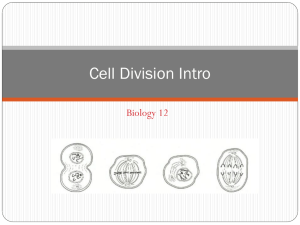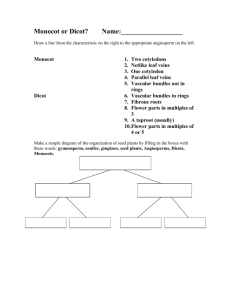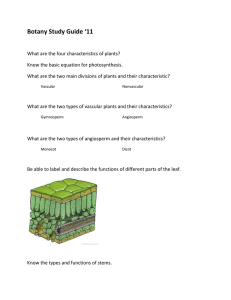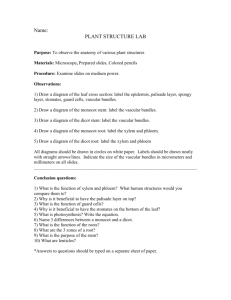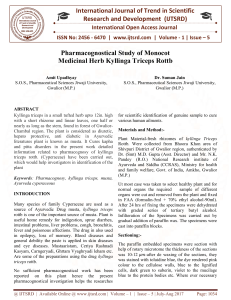LOYOLA COLLEGE (AUTONOMOUS), CHENNAI – 600 034
advertisement
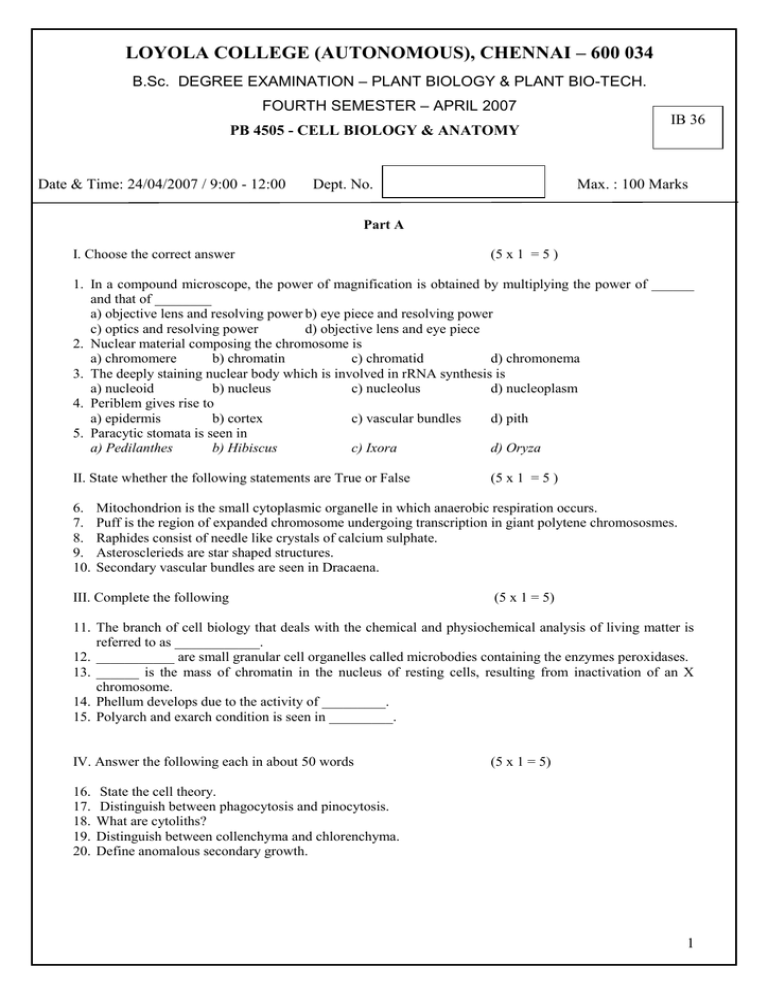
LOYOLA COLLEGE (AUTONOMOUS), CHENNAI – 600 034 B.Sc. DEGREE EXAMINATION – PLANT BIOLOGY & PLANT BIO-TECH. FOURTH SEMESTER – APRIL 2007 PB 4505 - CELL BIOLOGY & ANATOMY Date & Time: 24/04/2007 / 9:00 - 12:00 Dept. No. IB 36 Max. : 100 Marks Part A I. Choose the correct answer (5 x 1 = 5 ) 1. In a compound microscope, the power of magnification is obtained by multiplying the power of ______ and that of ________ a) objective lens and resolving power b) eye piece and resolving power c) optics and resolving power d) objective lens and eye piece 2. Nuclear material composing the chromosome is a) chromomere b) chromatin c) chromatid d) chromonema 3. The deeply staining nuclear body which is involved in rRNA synthesis is a) nucleoid b) nucleus c) nucleolus d) nucleoplasm 4. Periblem gives rise to a) epidermis b) cortex c) vascular bundles d) pith 5. Paracytic stomata is seen in a) Pedilanthes b) Hibiscus c) Ixora d) Oryza II. State whether the following statements are True or False 6. 7. 8. 9. 10. (5 x 1 = 5 ) Mitochondrion is the small cytoplasmic organelle in which anaerobic respiration occurs. Puff is the region of expanded chromosome undergoing transcription in giant polytene chromososmes. Raphides consist of needle like crystals of calcium sulphate. Asterosclerieds are star shaped structures. Secondary vascular bundles are seen in Dracaena. III. Complete the following (5 x 1 = 5) 11. The branch of cell biology that deals with the chemical and physiochemical analysis of living matter is referred to as ____________. 12. ___________ are small granular cell organelles called microbodies containing the enzymes peroxidases. 13. ______ is the mass of chromatin in the nucleus of resting cells, resulting from inactivation of an X chromosome. 14. Phellum develops due to the activity of _________. 15. Polyarch and exarch condition is seen in _________. IV. Answer the following each in about 50 words 16. 17. 18. 19. 20. (5 x 1 = 5) State the cell theory. Distinguish between phagocytosis and pinocytosis. What are cytoliths? Distinguish between collenchyma and chlorenchyma. Define anomalous secondary growth. 1 Part B Answer any five of the following each in about 350 words. Draw necessary diagrams. (5 x 8 = 40) 21. Explain the working principles and the components of the electron microscope. 22. Briefly describe the structure and function of Golgi apparatus. 23. Comment on the shape, size and structure of the typical somatic chromosome. 24. List out the significant events that occur during metaphase, anaphase and telophase of mitotic divisions. 25. Write notes on the ultra structure of plant cell. 26. Explain the organization of shoot apex according to Histogen theory and tunica corpus theory. 27. Explain briefly about the types of meristems. 28. Discuss the anomalous secondary growth seen on Aristolochia. Part C Answer the following questions in about 1500 words. Draw necessary diagrams (2 x 20 = 40) 29. a. Describe the ultrastructure and function of the endoplasmic reticulum. (or) b. Explain the various stages of meiosis. 30. a. Explain in detail the structure of vascular bundles and vascular cambium. (or) b. Explain the following: i) Structure of dicot leaf ii) Structure of Phloem **************************** 2

